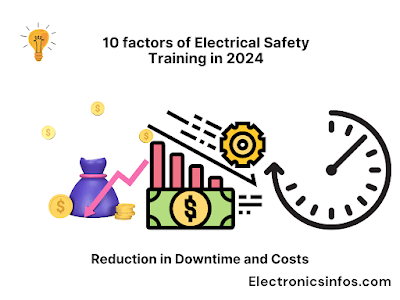What is Electrical Safety Training?

10 factors of Electrical Safety Training

Electrical Safety Training is like going to a class where you learn how to stay safe when dealing with electricity. Imagine it's like learning how to ride a bike safely so you don't get hurt. Electrical Safety is an important factor when we deal with high voltages. Electricity can be dangerous, causing shocks, burns, fires, and even major fatalities. Training teaches people how to work safely with electrical equipment to avoid accidents.
What Need for Electrical Safety?
Electrical safety training is essential for preventing electrical accidents, complying with regulations, protecting personnel and property, reducing risks, preparing for emergencies, promoting maintenance and inspection practices, and fostering a culture of safety. Electrical safety training is vital for numerous reasons, as it addresses the specific hazards and risks associated with electrical systems and equipment. There are 10 important factors of electrical safety training including
10 Factors of Electrical Safety Training in 2024
- Understanding Electrical Hazards
- Prevention of Accidents and Injuries
- Compliance with Safety Regulations
- Creation of Safety Culture
- Risk Reduction
- Emergency Preparedness
- Equipment Maintenance and Inspection
- Reduction in Downtime and Costs
- Ongoing Education and Updates
- Emergency Response and First Aid
Understanding Electrical Hazards
Understanding electrical hazards is necessary for maintaining a safe working environment. Electric shock, arc flash, electrical fires, electrocution, electrical burns, environmental hazards, and overloaded circuits are some of the key hazards associated with electricity.
Electric shock occurs when the body comes into contact with an electric current. Electrical fires can occur due to faulty wiring or equipment, leading to property damage and safety risks.
Electrical burns can result from direct contact with live conductors or arc flashes, causing significant damage to the body. Environmental factors like moisture, extreme temperatures, and corrosive substances can also pose hazards. Overloaded circuits, can lead to potential fire risks.
By understanding these hazards, individuals can implement proper safety measures, follow guidelines, and ensure the use of appropriate personal protective equipment (PPE). Regular training and awareness programs play a vital role in educating individuals about these hazards.
Prevention of Accidents and Injuries
Preventing accidents and injuries is a primary objective of electrical safety measures. Here are some essential points related to the prevention of accidents and injuries
- Risk Assessment
- Safety Training
- Use of Personal Protective Equipment (PPE)
- Equipment Maintenance
- Safe Work Practices
- Electrical System Design
- Ongoing Monitoring and Auditing
By prioritizing accident prevention through risk assessment, safety training, proper use of PPE, equipment maintenance, safe work practices, proper system design, and ongoing monitoring, organizations can create a safer work environment. It also reduces the occurrence of accidents.
Compliance with Safety Regulations
Compliance with safety regulations means following the rules and guidelines that are in place to keep everyone safe. Compliance with safety regulations is important for ensuring electrical safety. Safety regulations are created by government agencies and industry organizations to protect from electrical hazards. Safety compliance is necessary for all industries and businesses, to ensure safety . Regulatory bodies just as OSHA, NIOSH, and ANSI Ensure to follow the rules and regulations. These regulatory bodies also impose fines and penalties if businesses are involved in non-compliance with rules and regulations.
 |
| 10 factors of Electrical Safety Training |
Safety compliance provides a range of benefits for both businesses and employees including
- Compliance with safety regulations ensures that employees are provided with a safe working environment.
- Following safety regulations helps businesses avoid penalties, fines, and legal liabilities.
- A safe work environment leads to increased employee morale, motivation, and productivity.
- Safety compliance can lead to cost savings by reducing workplace accidents, injuries, and illnesses.
- Businesses that prioritize safety compliance build a positive reputation among employees, customers, and stakeholders.
- Fewer accidents and injuries result in reduced downtime due to fewer disruptions in operations.
- Compliance with safety regulations helps businesses identify, assess, and manage risks effectively.
Best Practices For Maintaining Safety
Maintaining safety compliance involves adopting best practices that ensure a safe working environment
- Provide regular safety training for employees to educate them about safety protocols, procedures, and regulations.
- Conduct regular risk assessments to identify potential hazards, evaluate risks, and implement control measures to mitigate them.
- Develop clear safety policies and procedures.
- Implement a regular maintenance schedule for equipment, machinery, and tools.
- Provide appropriate PPE such as helmets, gloves, goggles, and safety shoes to employees and ensure they are trained in their proper use and maintenance.
- Develop and practice emergency response plans, including evacuation procedures, and first aid protocols.
- Conduct regular safety audits and inspections to assess compliance with safety regulations.
- Maintain accurate records of safety training, inspections, incidents, and corrective actions.
- Continuously review and update safety practices, policies, and procedures.
Creation of Safety Culture
Creating a safety culture is important for promoting electrical safety within organizations. Safety culture means every employee should be included in a safe environment. Employees including Managers, Supervisors, contractors, operators etc
 |
| 10 factors of Electrical Safety Training |
Creating a safety culture is a long process that requires a solid foundation. Continuous improvement is a fundamental aspect of a safety culture. Regular safety audits, evaluations, and feedback mechanisms help identify areas for improvement.
Why do we need to create a safety culture?
- The primary reason is to protect the health, well-being, and lives of employees, contractors, and visitors.
- Creating a safety culture helps organizations comply with local, national, and international safety regulations, standards, and laws.
- A strong safety culture can lead to cost savings by reducing expenses
- A safety culture helps organizations identify, assess, mitigate, and manage risks.
- Safety culture fosters a culture of continuous improvement, innovation, creativity, problem-solving, and collaboration.
- Promoting a safety culture demonstrates the organization's commitment to social responsibility.
Risk Reduction
Risk Reduction involves implementing measures and strategies to minimize electrical systems' potential risks and hazards. Organizations can create a safer workplace environment and reduce accidents, injuries, and property damage by effectively reducing risks.
 |
| 10 factors of Electrical Safety Training |
Implementing engineering controls is an important aspect of risk reduction. This involves designing electrical systems and equipment with built-in safety features that mitigate risks. Examples of engineering controls include the installation of ground fault circuit interrupters (GFCIs), circuit breakers, and insulation to minimize the likelihood of electrical shock, fires, and equipment failures.
Personal Protective Equipment (PPE) is another critical element of risk reduction. Providing employees with appropriate PPE, such as insulated gloves, safety goggles, and flame-resistant clothing.
Emergency Preparedness
Emergency preparedness enables organizations to effectively respond to emergency situations related to electrical hazards. By having a well-developed emergency plan in place, organizations can minimize the impact of emergencies.
 |
| 10 factors of Electrical Safety Training |
emergency preparedness is conducting a thorough risk assessment to identify potential emergency scenarios specific to electrical hazards.
Evacuation planning is another aspect of emergency preparedness. Organizations should develop evacuation plans that identify assembly points, evacuation routes, and procedures for individuals with special needs.
Equipment Maintenance and Inspection
Regular maintenance and inspections ensure that electrical equipment is in optimal working condition. It reduces the risk of accidents, failures, and disruptions. By conducting routine maintenance tasks and inspections, organizations can identify potential issues.
 |
| 10 factors of Electrical Safety Training |
Equipment maintenance and inspections also play a critical role in ensuring compliance with regulations and safety standards.
During maintenance and inspections, potential hazards can be identified and addressed. Loose connections, worn-out insulation, damaged cords, or other issues that may pose a risk can be detected early on.
Reduction in Downtime and Costs
Regular equipment maintenance and inspections reduce downtime. By implementing a proactive maintenance strategy, organizations can minimize unexpected equipment failures, optimize performance, and maximize uptime.
Through routine inspections, potential issues or signs of equipment deterioration can be identified early on. This enables organizations to take preventive measures.
 |
| 10 factors of Electrical Safety Training |
Regular inspections and maintenance tasks help identify and address minor issues before they escalate, reducing the need for premature equipment replacements.
Another cost-saving aspect of regular maintenance is energy efficiency. Well-maintained equipment operates more efficiently, consuming less energy.
Ongoing Education and Updates
Regular education and updates provide professionals with the latest knowledge and information on safety regulations, codes, and standards.
 |
| 10 factors of Electrical Safety Training |
Furthermore, ongoing education enhances safety awareness among professionals.
ongoing education encourages collaboration and networking among professionals. Educational events and updates provide platforms for professionals to connect, share experiences, and learn from one another.
Emergency Response and First Aid
Emergency response and first aid training are essential components of electrical safety training. Emergency response training equips individuals with the necessary skills to assess the situation and take immediate action. This includes contacting emergency services, securing the area to prevent further accidents, and isolating the electrical source if possible.
First aid training is equally important as it enables individuals to provide immediate medical assistance to those injured in electrical accidents. This includes knowing how to assess injuries, administer CPR if necessary, and provide basic wound care.




-Electronicsinfos.png)



0 Comments
please do not insert spam links